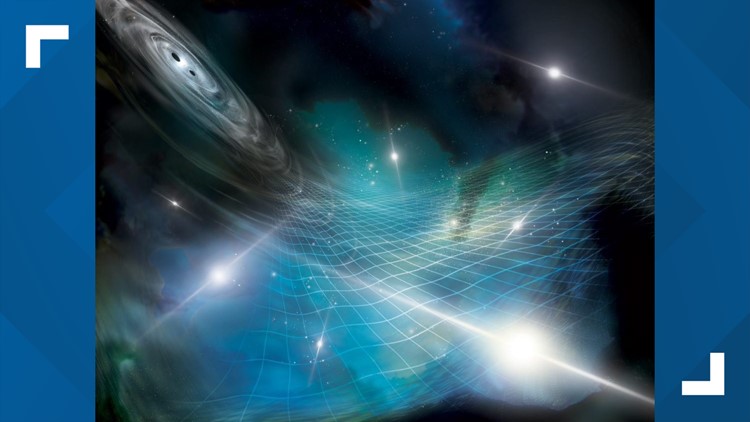LANCASTER, Pa. — A Franklin & Marshall College astrophysics professor is part of a large group of North American astrophysicists that teamed up to find evidence of gravitational waves that oscillate periodically from years to decades, the Lancaster college said Thursday.
Dr. Fronefield Crawford's contributions to the effort were part of a series of papers published Thursday in The Astrophysical Journal Letters, F&M said in a press release.
“By detecting and characterizing these kinds of signals, we’re really opening up a new window into studying and understanding the objects that are producing those signals, how they evolve, and how they connect to the evolution of the universe as a whole,” Crawford said.


The team, using large radio telescopes directed toward a collection of cosmic clocks in the Milky Way Galaxy, observed signals in 15 years of data acquired by the North American Nanohertz Observatory for Gravitational Waves (NANOGrav) Physics Frontiers Center (PFC), a collaboration of more than 190 scientists who use pulsars to search for gravitational waves.
“The basic idea is that we use a collection of radio pulsars in our galaxy that act as extremely precise clocks, and by monitoring these pulsars over time, we are sensitive to the presence of weak gravitational waves,” said Crawford, the Charles A. Dana Professor of Physics and Astronomy and Director of F&M’s Grundy Observatory.
While NANOGrav’s earlier results uncovered an enigmatic timing signal common to the pulsars they observed, it was too faint to reveal its origin. The 15-year data release demonstrates that the signal is consistent with slowly undulating gravitational waves passing through our galaxy.
“This is the first evidence for gravitational waves at very low frequencies,” said Vanderbilt University’s Stephen Taylor, who co-led the search and is the current chair of the collaboration.
Unlike fleeting high-frequency gravitational waves seen by ground-based instruments like LIGO (the Laser Interferometer Gravitational-wave Observatory), this continuous low-frequency signal is perceived only with a detector much larger than the Earth.
So, astronomers turned the Earth’s sector of the Milky Way galaxy into a huge gravitational-wave antenna by making use of exotic stars called pulsars. NANOGrav’s 15-year effort collected data from 68 pulsars to form a type of detector called a pulsar timing array.
A pulsar is the ultradense remnant of a massive star's core following its demise in a supernova explosion. Pulsars spin rapidly, sweeping beams of radio waves through space so that they appear to “pulse” when seen from the Earth. The fastest, called millisecond pulsars, spin hundreds of times a second. Their stable pulses make them useful as precise cosmic timepieces.
“Our approach is a bit unusual: In a typical scientific experiment, you would build a detector to detect a signal, and then you would run an experiment by collecting some data and making some measurements,” Crawford said. “Here, instead of building a physical detector, we’re finding new pulsars in our galaxy that act as our gravitational wave detector.”
With more than 15 years of observations with the Arecibo Observatory in Puerto Rico, the Green Bank Telescope in West Virginia and the Very Large Array in New Mexico, NANOGrav has gradually expanded the number of pulsars they observe.
“Pulsars are actually very faint radio sources, so we require thousands of hours a year on the world’s largest telescopes to carry out this experiment,” said Dr. Maura McLaughlin, a professor at West Virginia University and co-director of the NANOGrav PFC. “These results are made possible through the National Science Foundation’s (NSF’s) continued commitment to these exceptionally sensitive radio observatories.”
Among dozens of F&M students who have been working with Crawford over the last decade on finding pulsars for this project is rising senior Melanie Ficarra, an astrophysics major.
“My research involves identifying pulsars using data that has been collected using several large radio telescopes,” she said. “We follow certain criteria to determine if each candidate signal is a possible pulsar or not.”
Einstein’s theory of general relativity predicts precisely how gravitational waves should affect pulsar signals. By stretching and squeezing the fabric of space, gravitational waves affect the timing of each pulse in a small but predictable way, delaying some while advancing others. These shifts are correlated for all pairs of pulsars in a way that depends on how far apart the two stars appear in the sky.
“The large number of pulsars used in the NANOGrav analysis has enabled us to see what we think are the first signs of the correlation pattern predicted by general relativity,” said Oregon State University’s Xavier Siemens, co-Director of the NANOGrav PFC.



